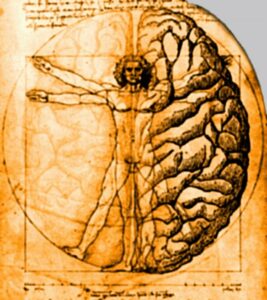Embodied cognition / Embodiment

|
‘Belichaamde cognitie’ (embodied cognition) is de theorie dat vele kenmerken van cognitie, al dan niet menselijk, worden gevormd door aspecten/eigenschappen van het gehele lichaam van het organisme. |
Internationaal is er de nodige aandacht voor onderzoek naar embodied cognition, zo ook in Nederland, bijv. bij deze groep ‘Embodied design’ embodieddesign.sites.uu.nl.
Verwijzingen
- Abrahamson, D. and Bakker, A. (2016). Making sense of movement in embodied design for mathematics learning (PDF) Cognitive Research: Principles and Implications, 1(1), 33. doi:10.1186/s41235-016-0034-3 .
- Duijzer, A. C. G., Van den Heuvel-Panhuizen, M., Veldhuis, M., Boom, J., Doorman, L. M. and Leseman, P. P. M. (2020). Moving towards understanding: Students interpret and construct motion graphs (PDF) Mediterranean Journal for Research in Mathematics Education, 17, 25-51. .
- Duijzer, A. C. G., Van den Heuvel-Panhuizen, M., Veldhuis, M. and Doorman, L. M. (2019). Supporting primary school students’ reasoning about motion graphs through physical experiences (PDF) ZDM – International Journal on Mathematics Education, 51(6), 899–913. doi:10.1007/s11858-019-01072-6 .
- Duijzer, A. C. G., Van den Heuvel-Panhuizen, M., Veldhuis, M., Doorman, L. M. and Leseman, P. P. M. (2019). Embodied Learning Environments for Graphing Motion: a Systematic Literature Review (PDF) Educational Psychology Review, 31(3), 597-629. doi:10.1007/s10648-019-09471-7 .
- Fyhn, A. B. (2010). Climbing and Angles: A Study of how two Teachers Internalise and Implement the Intentions of a Teaching Experiment (PDF) TMME, 7(2,3), 275. .
- Johnson-Glenberg, M. C., Birchfield, D., Tolentino, L. and Koziupa, T. (2012). Technology-enabled Embodied Learning Environments: Two STEM Studies, Games, Learning & Society Conference 2012. Madison.
- Komen, A. (2017). Combining multiplication table practice with learning to juggle to improve enjoyment in a classroom setting (PDF). Amsterdam: Vrije Universiteit.
- Lakoff, G. and Nunez, R. (2010). Where Mathematics Comes From: How the Embodied Mind Brings Mathematics Into Being. New York: Basic Books.
- Lakoff, G. and Núñez, R. E. (2000). Where Mathematics Comes From: How the Embodied Mind Brings Mathematics into Being (PDF). New York: Basic Books.
- Leseman, P. and Van den Heuvel-Panhuizen, M. (2012). Perception-Action Affordances in Mathematics, Science and Technology Education (PDF). Utrecht: Utrecht University.
- Link, T., Moeller, K., Huber, S., Fischer, U. and Nuerk, H.-C. (2013). Walk the number line – An embodied training of numerical concepts Trends in Neuroscience and Education, 2(2), 74-84. doi:10.1016/j.tine.2013.06.005 .
- Marghetis, T. and Núñez, R. (2013). The Motion Behind the Symbols: A Vital Role for Dynamism in the Conceptualization of Limits and Continuity in Expert Mathematics Topics in Cognitive Science, 5(2013), 299–316. doi:10.1111/tops.12013 .
- Markusse, A. (2014). Wiscodans en Keerdans – leren over symmetrie via dans Reken-wiskundeonderwijs: onderzoek, ontwikkeling, praktijk, 33, 78-82. .
- Martin, J. (2008). Restructuring Activity and Place: Augmented Reality Games on Handhelds (PDF) In V. Jonker, G. Kanselaar, P. Kirschner and F. Prins (Eds.), International Conference of the Learning Sciences (ICLS). Utrecht, the Netherlands: ISLS.
- Niebert, K., Marsch, S. and Treagust, D. F. (2012). Understanding Needs Embodiment: A Theory-Guided Reanalysis of the Role of Metaphors and Analogies in Understanding Science (PDF) Science Education, 96(5), 849-877. doi:10.1002/sce.21026 .
- Núñez, R. (2006). Do real numbers really move? Language, thought and gesture: the embodied cognitive foundations of mathematics (PDF). In R. Hersh (Ed.), 18 Unconventional essays on the nature of mathematics (pp. 160-181). New York: Springer.
- Núñez, R. (2007). The cognitive science of mathematics: why is it relevant for mathematics education (PDF). In R. Lesh, E. Hamilton and J. J. Kaput (Eds.), Foundations for the Future in Mathematics Education (pp. 127-154). Mahwah, NJ: Lawrence Erlbaum Associates.
- Núñez, R. (2011). On the Science of Embodied Cognition in the 2010s: Research Questions, Appropriate Reductionism, and Testable Explanations (PDF) Journal of the Learning Sciences. doi:10.1080/10508406.2011.614325 .
- Núñez, R., Cooperrider, K. and Wassmann, J. (2012). Number Concepts without Number Lines in an Indigenous Group of Papua New Guinea (PDF) PLoS ONE, 7(4). doi:10.1371/journal.pone.0035662 .
- Núñez, R., Doan, D. and Nikoulina, A. (2011). Squeezing, striking, and vocalizing: Is number representation fundamentally spatial? (PDF) Cognition, 2011, 12. doi:10.1016/j.cognition.2011.05.001 .
- Núñez, R. E. (2011). No innate number line in the human brain (PDF) Journal of Cross-Cultural Psychology, 42(651). doi:10.1177/0022022111406097 .
- Smith, L. and Gasser, M. (2005). The Development of Embodied Cognition: Six Lessons from Babies (PDF) Artificial Life, 11, 13-29. .
- Van den Heuvel-Panhuizen, M. and Leseman, P. (2012). Embodied cognition and representational redescription in children’s understanding of phenomena in mathematics, science and technology (PDF). Utrecht: Universiteit Utrecht.
- Veeragoudar Harrell, S. and Abrahamson, D. (2007). Computational Literacy and Mathematics Learning in a Virtual World: Identity, Embodiment, and Empowered Media Engagement, CSCL 2007. New Brunswick, NJ, USA.
- Wijers, M. and Jonker, V. (2010). MobileMath: a location-aware game for mathematics (PDF). In E. Brown (Ed.), Location-based and contextual mobile learning: a report from the STELLAR Alpine Rendez-Vous workshop series (pp. 20-22). Nottingham: University of Nottingham: Learning Sciences Research Institute (LSRI).
- Wijers, M., Jonker, V. and Drijvers, P. (2010). MobileMath; exploring mathematics outside the classroom (PDF) ZDM International Journal on Mathematics Education, 42, 789-799. .


